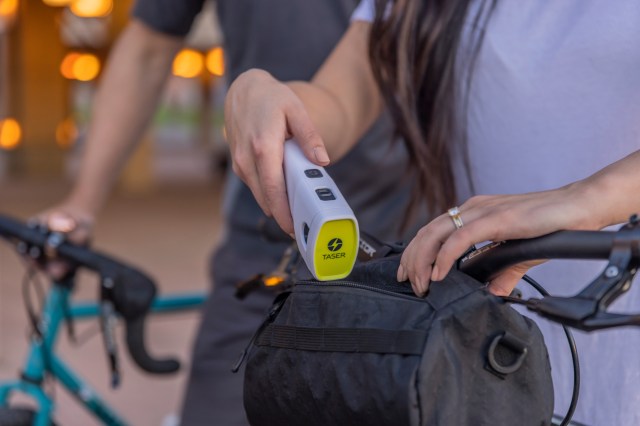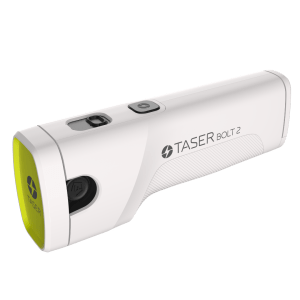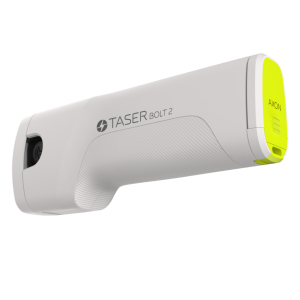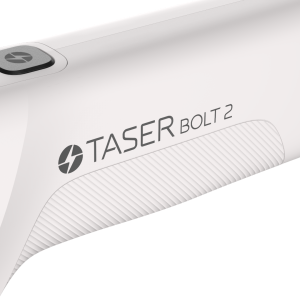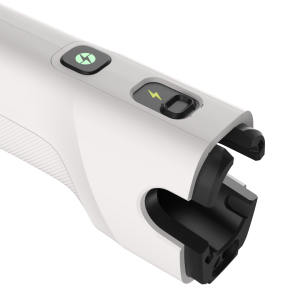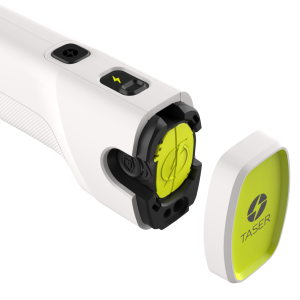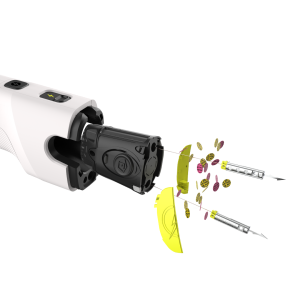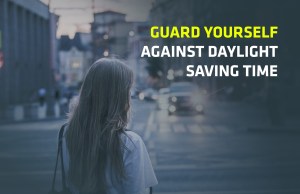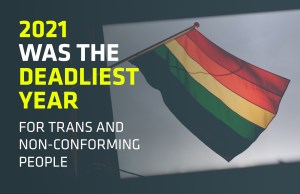A few weeks after joining Axon in early 2019, industrial designer Mark Eastwood stood on a collection of foam mats in the atrium of the company’s Scottsdale, Arizona headquarters. Two colleagues were positioned either side of him. Several feet away stood another, pointing a bright yellow TASER 7 non-lethal device right at him. After a steadying breath, the employee squeezed the TASER device’s trigger, flinging two probes carrying a 50,000-volt charge in Eastwood’s direction.
Eastwood fell into his companions’ arms almost instantly. “I had the experience of being completely incapacitated, 100 percent,” Eastwood says. “I didn’t experience any pain – I just couldn’t move.”
Five seconds later Eastwood rose back to his feet, unscathed. “It really changed how I look at what we offer,” he says. “And that was exciting.”
Other companies might offer their workers table tennis or an espresso machine. But almost three years on, Eastwood has been instrumental in crafting the TASER Bolt 2, Axon’s latest, smartphone-connected edition of the world’s most popular non-lethal energy device.
The Importance of Design
Shape conveys deep meaning for us all – deeper when it’s employed in the design of devices used in some of the most tense encounters possible. It’s a “non-verbal story on how the device is going to be used, how it makes the user feel, what it relates to,” says Eastwood. “It’s sort of like sculpture for consumer goods.”
Axon knows well how design informs the use of its wide range of self-defense devices. The TASER Pulse, developed from the law enforcement ranges that still lead Axon’s research and development team, looks like a small pistol, despite weighing in at a mere eight ounces. Its twin probes can immobilize attackers for up to 30 seconds, providing ample time to retreat from a life-threatening situation, while simultaneously preserving an attacker’s life.

The evolution of design: The original, now-retired, TASER Bolt/C2 pictured at top, a 3D-printed model of the new TASER Bolt 2 in middle, and the currently available TASER Pulse at bottom. The Bolt 2 is packed with the same non-lethal stopping-power of the TASER Pulse and its law enforcement relatives – but in a comfortable, discreet form factor.
The first incarnation of the TASER Bolt was something different than the Pulse you see today – this was slim with a contour shape, less evocative of a firearm. “It was the kind of consumer product you might associate with non-self defense,” says Eastwood. “It almost looked like a shaver, or something like that.” Science has continually proven that the presence of a gun in any altercation greatly increases the chance of violence. The TASER Bolt, therefore, offered users the opportunity to neutralize an attacker entirely, without carrying anything resembling a firearm.
The original TASER Bolt was discontinued to make way for the arrival of the TASER Pulse in 2016, but consumer research continued to show the desire for a device that didn’t directly mimic the look of a firearm. The new Bolt 2 continues to “consider the language of form,” Eastwood says, employing design-speak he’s carried across the automotive, sportswear and electronics industries in over 25 years. The Bolt 2, Eastwood claims, looks more like a flashlight than anything. “You immediately associate it with, ‘I’m carrying it, and I’m pointing it at somebody or something.'” he says. “(It’s) a companion you take with you, to provide a level of safety.”
An Evolution of Defense
Using electricity for defense is something novel for an industry whose longevity may, to pardon the pun, shock. The earliest electric defense devices were cattle prods, whose long barrels carried electrified prongs meant to stun cows through their thick hides. In 1935 NYPD cops pondered an “electric glove” to replace the regular billyclub. In 1965, amid political turmoil, a Massachusetts inventor filed a patent for a “a long-range device that worked like an electrified supersoaker.” None of those, of course, materialized.
But it was in 1974 that Jack Cover, a NASA researcher, developed “Thomas A. Swift’s Electric Rifle,” naming the device after his fictional childhood hero. The name TASER developed as a rough acronym of the name. But his “rifle” used gunpowder, earning it a classification by the Bureau of Alcohol, Tobacco and Firearms (ATF) as a bona fide firearm.
As technology advanced, an appetite for non-lethal devices increased. The early 1990s saw a succession of incidents involving police officers and unarmed civilians that inflamed tension and violence on the streets of major American cities. In 1993 neurobiology grad Rick Smith founded TASER International with a simple mission: end the violence and protect life. Two of Smith’s high-school football teammates had been shot dead in a parking lot, over an argument at a red light.
“I realized that the way humanity typically solves difficult problems is through innovation,” Smith later told Forbes. “This philosophy dates back to medieval times with the invention of sewage systems and aqueducts. Technology shifts have been the primary driver in lifting the human condition. I realized that the technology we are using for self-defense is a medieval technology.”
Smith searched the patent archives for anything that could provide an alternative to the baton or bullet. Pepper spray inflicted pain on an assailant, but pain wouldn’t always prevent an attack. Electricity, on the other hand, had the ability to remove somebody’s bodily control. Smith then discovered Jack Cover’s TASER. Cover was 73, and his device had been a commercial failure. But the pair camped in Cover’s garage and worked on another design – this time without the gunpowder. The ATF approved their new model, and Smith and Cover unveiled their revamped non-lethal TASER at the 1995 Consumer Electronics Show in Las Vegas.
“We looked in the mirror and said, ‘Why did we start this business? What is the problem we are trying to solve? Let us forget about money, what is our contribution to the world?’ We knew we needed to pivot into the professional market with police.”
In 1999 the company marketed its devices directly to law enforcement officials. A year later, more than 500 agencies had signed up, and cops protecting both the Republican and Democratic National Conventions in 2000 came equipped with TASER devices. The devices eliminated opposition to become one of law enforcement’s key lines of self-defense.
Law enforcement officers use the bulk of the 700,000-or-so TASER devices Axon has sold in its history, and officers have discharged them almost five million times. The company estimates these moments to have saved 260,040 cases of death or serious injury. Law enforcement is still “the core of what we do,” says Eastwood. “When you see what’s important to them, and how they work, you become invested in the tools that make their job easier. They can execute better on their mission.”
That effectiveness trickles down into consumer demand, adds Eastwood. There is certainly a need: Homicides by firearm leapt from 10,537 in 2019, to 13,620 in 2020. Firearm deaths have dominated the news cycle, polarizing public perception of them.
The Bolt 2 helps dampen that tinderbox. “You’re less likely to misinterpret the intentions of somebody carrying a sleek device than you are someone carrying a gun-form factor device,” says Eastwood.
And it’s connected. The Bolt 2 integrates with a safety platform linking the product to a user’s smartphone. Whenever a user fires the Bolt 2’s, the app connects a signal via the phone to live dispatchers, who track the user’s location and send emergency personnel if needed. It also helps Axon better shape the next generation of devices. It’s the perfect sidekick, and a source of added peace of mind.
“Not only do you tactily get this sense of security, self-defense and safety, but also this unseen quality of it in connecting to a larger umbrella network of security,” says Eastwood.
Non-Lethal Peace of Mind
Axon CEO Rick Smith has pledged to make the bullet obsolete by 2030. By then, he has said, “we’re going to have non-lethal devices so good, it will actually be a faster time to incapacitation more reliably than a police pistol.
“Five years ago, I would have said you never take a TASER to a gunfight,” Smith has added. “And I’ve started to challenge that and say, ‘Well, what if the TASER is the better gun?’ And what if it’s actually more effective – it just doesn’t leave the other person dead.”
“I do not believe that we will solve today’s challenges by yelling more emphatically about approaches that have been around for decades or by denigrating people with opposing views,” wrote Smith in his 2019 book The End of Killing: How our Newest Technologies Can Solve Humanity’s Oldest Problem. “We need new thinking and fresh ideas. We need to explore outside of the echo chambers and interact with people who think differently than we do.”
Smith has continued the company’s growth apace, rebranding it Axon in 2017. The firm has been integral in the development of police body cameras, consigning many “he said she said” scenarios to the past, according to Smith. “Elon Musk is a brilliant technologist, and his manifesto is to get us to Mars,” says Smith. “Mine is to figure out how we can get to a planet where people do not kill each other anymore, and technology could play a huge role in that.”
Mark Eastwood sees his role at the frontline of Smith’s lifelong cause. Having arrived (and been stunned, literally) he brought Axon’s design in-house, turning colleagues into sounding boards and ensuring the best ideas are discussed at length. Before settling on the Bolt’s new form, they iterated “quite a few” different shapes.
“The one-handed design resonated with most people because, if it’s a device that’s familiar enough to walk around with it and not project any intimidation, that’s attractive.
“If they want to make the statement, and emit more of an intimidating tone, they can buy the Pulse,” he adds. Eastwood isn’t trying to convince gun lovers to mothball their current defense tools, per se: “You still want to provide an alternative for them. Especially a non-lethal alternative. It’s a supplement.”
He’s trying to reinvent the wheel – not stop people walking. But three years into his work at Axon, Eastwood is “excited” about offering security to consumers – whatever the form.
“Everybody wants to feel safe,” he says. “That I can say with certainty.”
The TASER Bolt 2 is available now.

